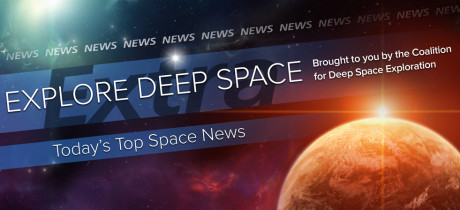In Today’s Deep Space Extra… U.S. House has joined the Senate in passing the NASA Transition Act of 2017. Supportive of the future human exploration of Mars, the measure will now go to the president for signature.
Human Deep Space Exploration
House passes NASA authorization bill
Space News (3/8): The U.S. House passed the NASA Transition Act of 2017 by voice vote Tuesday night to match action taken by the Senate in February. The policy-setting legislation, the first from Congress spelling out a bi-partisan course for the space agency since 2010, now goes to the president for signature. The act offers strong support for human deep space exploration, including a human mission to the Martian environs in the 2030s using the Space Launch System and Orion crew exploration capsule. “Today’s approval of the NASA Transition Authorization Act by Congress sends a clear message to the American people and our international partners that our nation remains committed to NASA’s space exploration program,” said Dr. Mary Lynne Dittmar, executive director of the Coalition of Deep Space Exploration, in a statement. The measure, Space News reports, calls for a larger private sector role in low Earth orbit as NASA moves outward, though it encourages an International Space Station extension from 2024 to 2028. The legislation questions the value of the robotic phase of NASA’s Asteroid Redirect Mission. It backs the James Webb Space Telescope, the Mars 2020 rover and a robotic mission to further assess the habitability of Jupiter’s moon Europa.
Cruz, Smith and Babin: A strong step for Texas, and one giant leap for space exploration
Houston Chronicle (3/7): In an op-ed, three Congressional leaders from Texas, U.S. Senator Ted Cruz, and U.S. Representatives Lamar Smith and Brian Babin, urge President Trump to sign the NASA Transition Authorization Act of 2017, which passed the U.S. House on Tuesday and the Senate last month. The measure would hold NASA spending steady for this year, while legislatively committing NASA to the human exploration of Mars with development of the Space Launch System and Orion crew exploration capsule, as well as a larger role for the U.S. private sector in low Earth orbit activities. Cruz chairs the Senate Subcommittee on Space, Science and Competitiveness; Smith chairs the House Science, Space and Technology Committee; Babin, chairs the House Space Subcommittee.
Lightfoot: NASA budget still in formulation, “confident” of administration support
Spacepolicyonline.com (3/7): NASA Acting Administrator Robert Lightfoot offered agency employees assurance Tuesday about the on-going 2018 budget process in a memo. The new Trump administration is still in the process of developing a spending proposal for the fiscal year that begins October 1. Currently, much of the U.S. government is operating under a budget continuing resolution that places 2017 spending at 2016 levels or $19.3 billion for NASA. A top line budget blueprint is due March 16, with a more detailed spending plan coming in May.
NASA SLS rocket’s ‘upper part’ tests underway | Video
Space.com (2/7): A new test facility at NASA’s Marshall Space Flight Center is ready to test the Space Launch System (SLS) exploration rocket upper stage and its various adapters under simulated flight-like conditions. The SLS, along with the Orion crew capsule, is a cornerstone of NASA’s efforts to return human explorers to lunar orbit and onto the Martian environs in the mid-2030s.
Space Science
What Going To Mars Will Do To Our Minds
538.com (3/6): Long human missions to Mars, like those envisioned by NASA and others, will bring psychological stresses from the isolation, confinement, risk, interpersonal conflict and long delays in communications with the home planet. In addition to screening flight candidates to assess who are best suited to deal with the challenges, missions sponsors must be prepared to offer support, even therapy from afar. Some research suggests the mid-point of a long mission can be a troubling milestone.
The ice volcanoes of Ceres were highly active a few million years ago
Popular Mechanics (3/6): Asteroid Ceres was volcanically active, perhaps persistently, about four million years ago, according to scientists from the Max Planck Institute who’ve assessed observations of the planetary body provided by NASA’s Dawn mission spacecraft. The asteroid’s most prominent ice volcano, Ahuna Dome, towers two and a half miles high.
Lightning from space: Satellite promises a ‘quantum leap’ in forecasting
USA Today (3/6): NOAA’s new GOES 16 weather satellite is bringing lightning and its impact on the environment, as well as severe weather under unprecedented scrutiny. The imager can take as many as 500 pictures a second. The geostationary satellite was launched into Earth orbit in November as GOES R.
Commercial to Low Earth Orbit
Military, industry hope 2017 means big improvements for space acquisition
Space News (3/7): The U.S. Department of Defense has reached a milestone, its best opportunity yet to leverage the capabilities of the nation’s commercial space industry, with its wide range of launch vehicles and satellite capabilities. The biggest road block to any kind of reform, however, is money and resources, according to Jeffrey Trauberman, vice president of space, intelligence, and missile defense systems for Boeing Satellite Systems International. The discussion unfolded at Satellite 2017 conference underway this week in Washington.
Eutelsat first customer for Blue Origin’s New Glenn
Space News (3/7): Blue Origin’s New Glenn rocket has its first customer, Eutelsat, the European commercial satellite operator. New Glenn, with a reusable first stage, promises to be one of the most powerful rockets in its class. Speaking before the Satellite 2017 conference in Washington, Blue Origin founder Jeff Bezos said New Glenn launches will begin in 2020. Eutelsat’s mission is planned for a year or two after.

